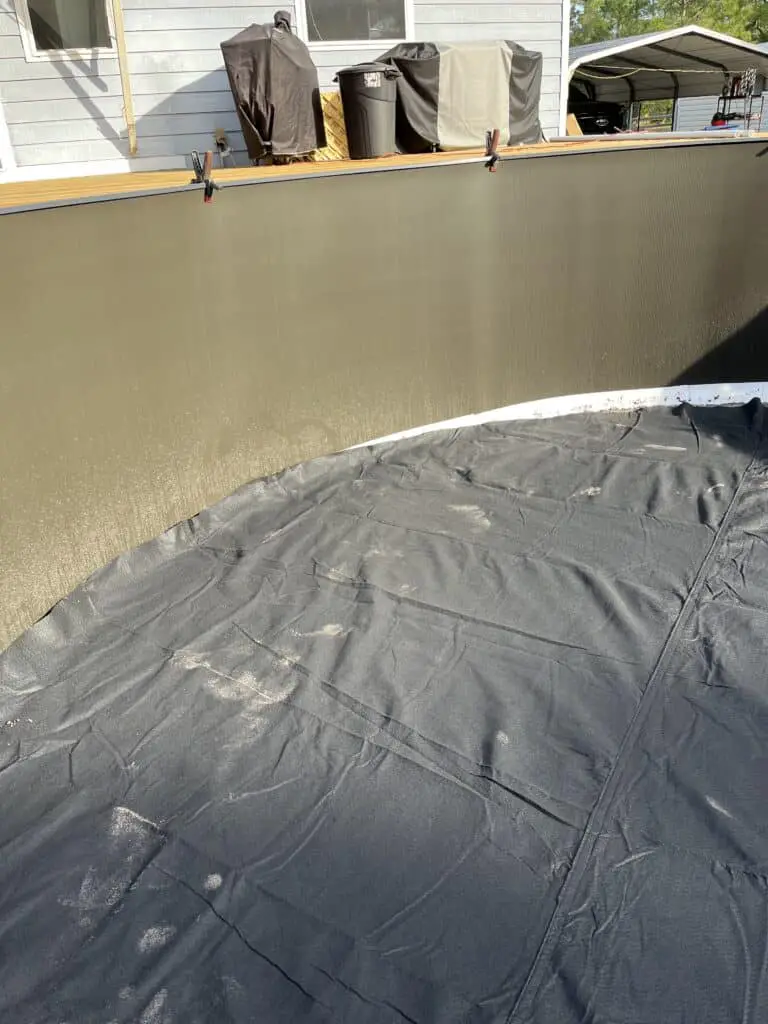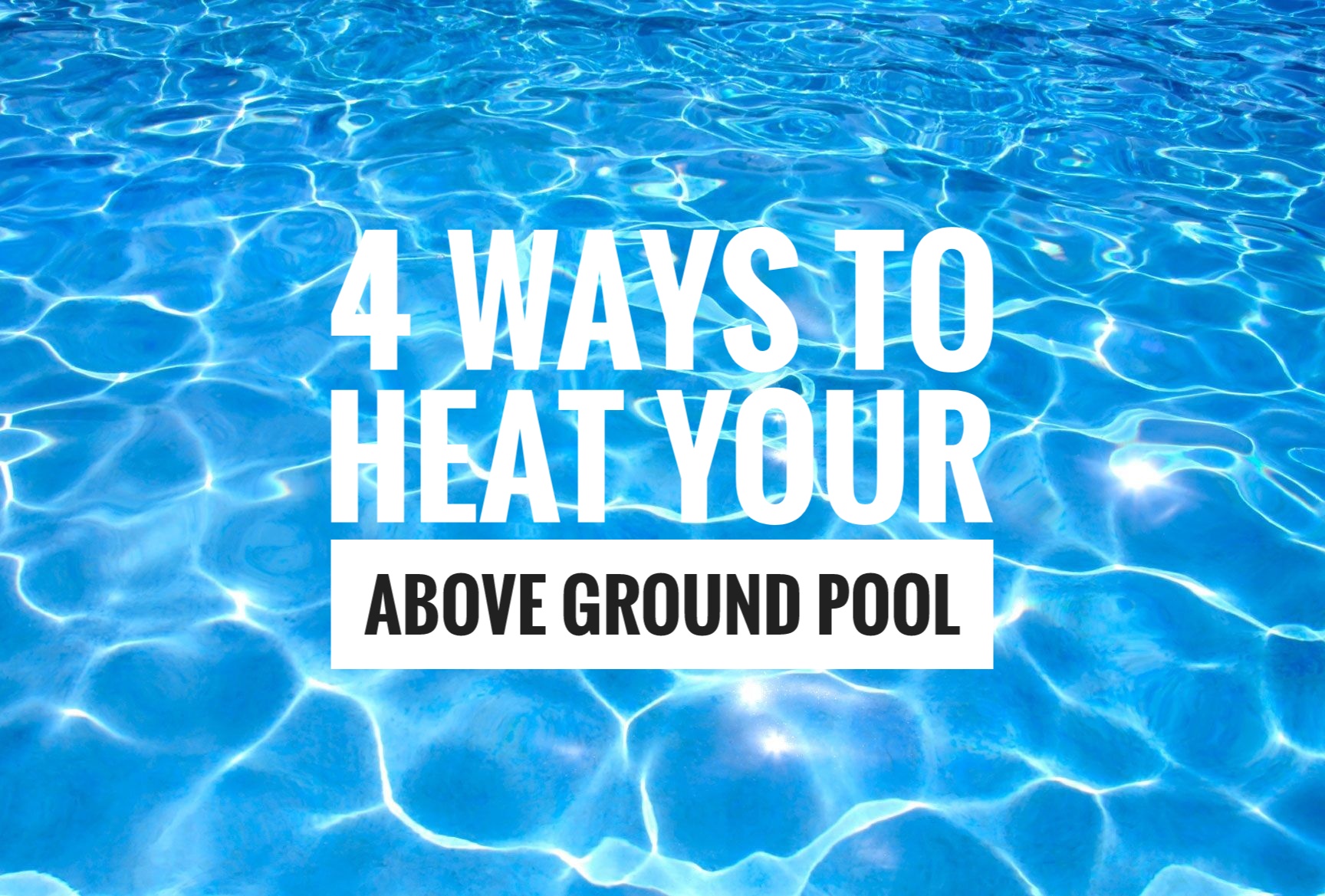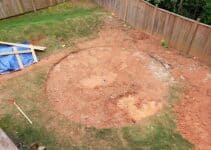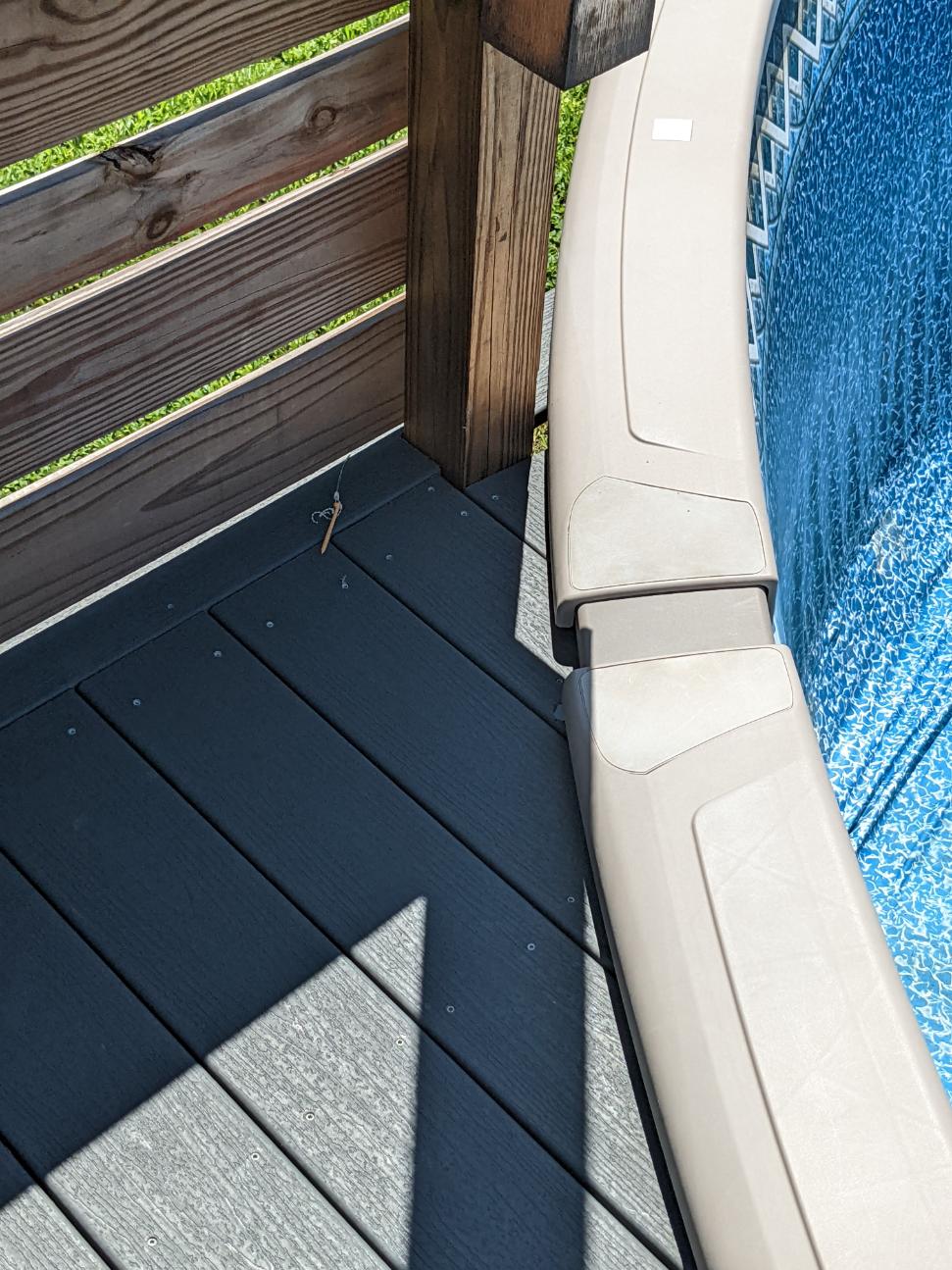If you found this article, then you probably know what a liner guard for an above-ground swimming pool is.
As an above-ground pool installer for thirty-seven years, I was around when there was no such thing as a liner pad/guard. In the past fifteen years or so, they have become quite popular.
In truth, above-ground pool liner guards and pads are all equally effective in offering mild protection from harmful and sharp things in the earth. Some are white and some are black, but all are made of synthetic materials and are about the same.
THE HISTORY OF THE ABOVE-GROUND POOL LINER GUARD
There’s not much to tell here about how liner pads came about, but since you are doing all the research you possibly can about above-ground pools, you might as well know this quite useless information along with most everything else.
So, back in the day, when many above-ground pools were put up in stores as displays and filled with water, the liner of the pool would set down against the concrete floor of the showroom.
For some reason (still unknown to me) these display pools would often get pesky little leaks in them. This was a bigger deal than normal as there would be water on the floor inside a showroom. Not good.
Store operators, thinking that the leaks were maybe created by the direct contact of the pool liner and the concrete floor, then started using things like thin carpet or foam sheeting as a barrier between the liner and the concrete.
This seemed to help a lot to prevent leaks, so then every time I built a display pool, I would have to use something to put down before the liner went in
This was ok but the bottom of these display pools might look a little lumpy or inconsistent when potential customers would look down in them. Then someone had the good idea of taking thin blankets and putting them down instead. The blankets were thinner so the pool bottom would look better.
At some point somewhere (I don’t profess to know who or where), someone had a piece of thin blanket-like material made that could be cut to fit the bottom of an above-ground display pool.
This worked very well, so after they started making these for display pools, people started buying and using them whenever they put a pool on concrete at home.
Then someone said, “You should use one of these pads even when installing the pool on the ground”. So, this new product that could be sold to everyone called the “liner pad” was born.
AND HERE’S A LITTLE MORE HISTORY
As an installer in the 1990s, some of the pool packages would come with this thing called a liner pad. And it was annoying. I mean, above-ground pools have been successfully installed for decades without the help of this new add-on.
At first, I only saw it as just one more step I had to take before I could complete the install and get paid. Plus, it didn’t come precut and I had to make it fit whatever size pool I was doing which was a pain.
After a while, I started getting used to installing the liner pad as it was gaining in popularity(mostly from the pool store salesmen selling it as an upgrade) and I found something positive about it.
Installing it was an extra step, but I didn’t have to worry as much about leaving something sharp in the earth that could cut the liner. That pad may not stop the customer from feeling a sharp rock or piece of glass under the liner, but it might stop it from making a hole.
Eventually, the liner pad started coming pre-cut to fit different size pools which was a nice improvement for the installer. At that point, there was really only one liner pad that came from one place.
Then, sometime in the early 2000s I’m guessing, this product called the “gorilla pad” came out.
For the first two or three years, this gorilla pad was a better product than the original generic liner pad. The material seemed tougher and it definitely was cut for a better fit and laid down better on the ground. I think that in those first years, the gorilla pad was made in North America. Soon after though, whoever made it started having it made in China and you can probably guess the rest.
Yeah, the gorilla pad lost its quality.
After five years or so of the Gorilla pad dominating the market of liner guards for above-ground pools (Yeah, not as impressive as it sounds), other products came out to compete with it. And since “gorilla” was such a successful marketing name, the elephant, rhino, and other tough animal name pads were now for sale.
During this time when deciding on which above-ground pool pad could remind you of watching Jumanji, the term “liner guard” was born. This was because some of the bigger manufacturers of things like Gladdon were simply calling their product “liner guard”.
LINER PADS VS LINER GUARDS. WHAT’S THE DIFFERENCE?
In a hurry? Then read no further. There is absolutely no difference!
The name liner “guard” certainly isn’t as sexy as a big, mean, intolerant African alpha animal pad, but it is more accurate. Probably the only thing I have to tell people about this add-on product is that these things called “pads” aren’t pads at all and provide no padding whatsoever.
Liner guards AND pads are like U-haul type blankets and offer no padding or smoothing/leveling effect to the finished product of the bottom of an above-ground pool.
People often think they are buying something that is going to help with the flatness, smoothing, or consistency of the pool’s bottom. It will not! This is why the term “guard” is more accurate than “pad”.
A LIST OF THE DIFFERENT LINER GUARD NAMES
1 Gorilla pad
In some cases, the original is still the best. This is NOT the case with the gorilla pad. They aren’t one bit better than any other pad. This pad is usually black in color
2 Rhino pad/guard
I have noticed that this item often comes a little bigger than the size of the pool. This is just slightly more annoying than if the pad comes too small. I have seen what is called a Rhino guard come in both black and white.
3 Armor shield
This is a very popular name for a floor pad for an above-ground pool. And it sounds strong, like a steel mesh chest cover worn by the Knights of Templar or something.
Despite its unassailable name, this product is made with the same material as any other mildly named liner pad/guard. And it doesn’t fit any better either.
4 Liner guard
Fortunately for the sake of simplicity, this term is becoming more popular when naming this ground pad item. It is, in my opinion, the most accurate name for what this product really is.
WHAT CAN A HAVING A LINER GUARD FOR AN ABOVE-GROUND POOL PROTECT YOU FROM?
In the real world (where your pool is and not here), a liner guard doesn’t do much. But it does do something. Here is what it does:
A- Protects the floor of the liner if the pool is set on concrete
The original purpose for this product is still in play. This is the best item to use if you are putting your above-ground pool on concrete.
B- Will offer some extra protection from something sharp left in the ground cutting the pool’s liner
It’s very uncommon for anything sharp under a liner to poke through and make a hole in it. This is because a vinyl liner will give some and wrap itself around the poking object instead of breaking. ( A lot like trying to poke a needle through a rubber band)
Having a liner guard between the sharp item and the liner though will make it even tougher for a hole to happen.
C- Will allow you to tap something sharp on the pool’s floor flat (so you no longer feel it)
In most cases when something sharp is left in the ground under the liner of an above-ground pool, it can simply be tapped down flat using a hammer and a piece of wood. Problem solved.
Sometimes though when you tap something down, it will make a small hole in the liner, which can just be easily patched underwater.
If there is a liner guard installed, the likelihood of making a hole in the liner when tapping something down is lessened as it will be in between something sharp and the liner.
D- Can help make a barrier for nutgrass killer
Fun Fact: A liner guard will NOT prevent nutgrass from growing through the pool’s liner.
Nutgrass is a nasty customer. Nothing short of a concrete floor will 100% guarantee that it won’t damage the liner(if present in the ground)
Using a quality granular nutgrass killer will help a lot though. And using a ground pad/liner guard in addition to the killer works even better at preventing nutgrass from growing through the liner
THINGS THAT HAVING A LINER GUARD IN AN ABOVE-GROUND POOL WILL NOT DO
Due to some of the names of this product AND salespeople not really knowing anything about it, many will think that a liner guard will offer protection that it just won’t. Here’s what one won’t do for you:
A- Will NOT make the pool’s bottom smoother or flatter
Liner guards are more like a light blanket. It is not rigid in any way, so don’t expect it to improve your pool bottom in terms of smoothness or flatness.
B- It will NOT prevent you from feeling rocks or sharp objects left in the earth
Again, because this product is like a blanket, it will not insulate anything that is poking up on the pool’s floor. You will feel it the same whether you have a liner pad or not.
C- It will NOT prevent mole damage
Moles make ruts under above-ground pools. A liner guard will not prevent this from happening. It will simply contour to the new ruts just like the liner will.
D- It will NOT prevent nutgrass from growing through the liner
I think most retailers stopped saying that liner guards will prevent nutgrass damage, but I will still occasionally hear of someone being told that.
I have noticed that a liner pad/guard will stop some nutgrass from making it through a liner, but don’t count on that.
E- It will not prevent termite damage
Termites eating the pool liner is rare and odd. It’s one of those things that I think that’s what it was (that damaged the liner) but can’t say for sure.
Regardless, if someone told you or you think termites took life from your pool liner, then cool. Just don’t think that adding a liner guard will protect you from that in the future.
HOW TO INSTALL A LINER GUARD
Installing a liner guard is maybe the simplest part of the pool install. Unless you make it difficult.
1 Build or install your pool cove, then get the pool’s bottom as flat and smooth as you can.
2 Apply granular nutgrass killer using a spreader to make it evenly dispersed
3 Unfold and spread out the liner guard. Make it as even as you can against the wall of the pool, but don’t stress about it. (liner guards aren’t cut very precisely)
Yes. The liner guard goes OVER the pool coving.
Don’t worry about getting out any folding wrinkles from the liner guard. You won’t get them out anyway and you won’t feel them after the pool is full of water.
4 Unfold and set the pool liner directly on top of the liner guard.
INSTALLER NOTE: I have seen DIYers put the liner guard down and then a layer of earth or sand. Yeah, don’t do this. It’s called a liner “Guard”. Install it directly under the liner so it guards the liner.
A COUPLE MORE RANDOM THINGS TO KNOW ABOUT LINER GUARDS FOR ABOVE-GROUND POOLS
Liner guards don’t fit well

Some liner guards are too small and some are too big. Just get it in place as good as you can and move on. You won’t feel any excess around the bottom of the pool wall once the pool is filled with water.
Liner guards go on TOP of the coving
Some will install the liner guard first, then make or install the pool coving.
While this won’t hurt anything, you are moving around the pool when installing the coving, which can damage your nice smooth pool bottom. And you won’t know it because the liner guard is already in place.
Get your pool bottom completely done with the coving in place, then put your floor pad down. The pool’s bottom will come out nicer.
A liner guard may not be reusable when changing the liner
A quality liner will last between five and eight years on average before needing to be replaced.
When replacing a liner, it’s customary to redo the pool’s bottom as it may have gotten bumpy from earth dynamics, mole damage, or roots.
Sometimes the existing liner guard will have a layer of growth on it and will not be reusable. This is because it will have earth and algae stuck to it and resetting it will make your pool bottom bumpy.
If installing the liner without a vacuum, having a liner guard will make it easier to pull the wrinkles out of the liner while setting it.
As a pool installer of more than 7k pools over 37 years, I very rarely use a vacuum to get the wrinkles out of the liner.
I instead start adding water to the pool and pull the wrinkles from the center outward until I get to the walls of the pool.
With a liner guard underneath the liner, it’s easier to pull the wrinkles out of the liner as it moves better than if just laying on earth or sand.



Hello,
I really appreciate you articles and advice thank you 🙂
I am wondering if there is any harm in doubling the liner guard, the pool place gave me 2 for some reason with my kit.
Thank you
Matthew
No harm at all except you might have a harder time getting the wrinkles out of the liner.
My pool store gave me a 18×33 liner guard and wrote on the box “cut to fit for 15×30.” Well, my installers didn’t cut it. They folded the extra fabric toward the center of the pool along the whole oval. Now you can see/feel the folds under the liner. I wouldn’t quite call them wrinkles. Is this acceptable? Will they become wrinkles?
Liner guards don’t come cut well at all. I commonly allow the guard to fold at the bottom of the wall with no issues of feeling the double material. In your more extreme case of leaving it folded in the center of the pool, I don’t know if the weight of the water will press the extra material down enough to not feel. And I don’t think it was a good decision by the installer to not cut it, but don’t think it’s worth trying to fix either.